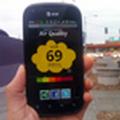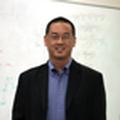News Releases
Small, Portable Sensors Allow Users to Monitor Exposure to Pollution on Their Smart Phones
December 18, 2012
Computer scientists at the University of California, San Diego have built a small flee...
Juan C. Lasheras Named Interim Dean of the Jacobs School
December 13, 2012
The University of California, San Diego today announced the appointment of Juan C. Lasheras as In...
Pioneer in Physical Design of Integrated Circuits Named ACM Fellow
December 12, 2012
Andrew B. Kahng, a professor of electrical engineering and computer science at the Uni...
In vitro study finds digested formula, but not breast milk, is toxic to cells
December 10, 2012
Free fatty acids created during the digestion of infant formula cause cellular death that may con...
New Biomaterial gets 'Sticky' with Stem Cells
December 7, 2012
Just like the bones that hold up your body, your cells have their own scaffolding that holds them...
DELPHI Project Foretells Future of Personalized Population Health
December 5, 2012
Imagine a new type of healthcare app that does it all. It helps you understand your current healt...
Jacobs School Student Named FAA Outstanding Student of the Year
November 30, 2012
A Ph.D. student at the University of California, San Diego, has been named one of two ...
Two Jacobs School Engineers Named AAAS Fellows
November 29, 2012
Two faculty members at the Jacobs School of Engineering at UC San Diego have been named fellows o...
California High School Girls Build Experiment for Space Station
November 27, 2012
Fifteen girls from high schools around San Diego County have been meeting once a week since Septe...
Cultural Heritage Center at UC San Diego Reports Progress in 2012
November 26, 2012
The number of Ph.D. students participating in the Center of Interdisciplinary Science ...
Engineering Graduate Student Wins Collegiate Inventors Competition
November 16, 2012
For work toward a safer approach to treating cancer, electrical engineering Ph.D. student Inanc O...
Jacobs School Shines at Fluid Dynamics Conference
November 15, 2012
Simulations that help doctors perform life-saving surgeries; a better way to model cli...
Crowdsourcing Feature Lets iPhone Users Determine Best Time to Cross U.S. Border
November 8, 2012
Next time you drive into the United States from Mexico or Canada, you may want to open a new iPho...
Pavements Designed to Fight Climate Change Could Increase Energy Consumption in Surrounding Buildings
November 7, 2012
A push to replace old, heat-trapping paving materials with new, cooler materials could...
Researchers Launch Innovative, Hands-on Online Tool for Science Education
October 22, 2012
Computer scientists at the University of California, San Diego and at St. Petersburg A...
MONTHLY NEWSLETTER
Get the latest Jacobs School research and education highlights once a month, straight to your inbox.
Recent News

Small, Portable Sensors Allow Users to Monitor Exposure to Pollution on Their Smart Phones
December 18, 2012
Computer scientists at the University of California, San Diego have built a small flee...

Juan C. Lasheras Named Interim Dean of the Jacobs School
December 13, 2012
The University of California, San Diego today announced the appointment of Juan C. Lasheras as In...

Pioneer in Physical Design of Integrated Circuits Named ACM Fellow
December 12, 2012
Andrew B. Kahng, a professor of electrical engineering and computer science at the Uni...

In vitro study finds digested formula, but not breast milk, is toxic to cells
December 10, 2012
Free fatty acids created during the digestion of infant formula cause cellular death that may con...

New Biomaterial gets 'Sticky' with Stem Cells
December 7, 2012
Just like the bones that hold up your body, your cells have their own scaffolding that holds them...
